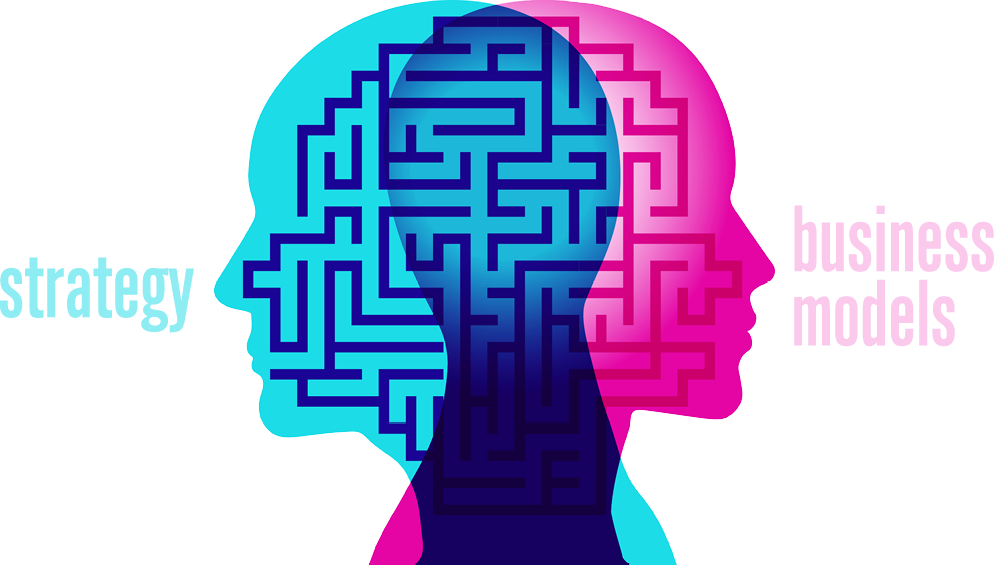Strategy and business models: indistinguishable or distinct and complementary?
by Dr James Mills & Dr Marc Levy
Right Thinking
Academics and executives have been debating the merits of different business models since the 1950’s, but what does the term ‘business model’ actually mean, and is it distinct from a corporate strategy? We believe that the two concepts are complementary descriptions of an organisation’s approach to winning in the market. Each represents a different cognitive approach, and both are essential for leaders to contemplate when charting the course for their organisation.
 Though most agree that the two terms strategy and business model have distinct meanings, there is no general consensus on precisely what it is that differentiates the two concepts. There is, however, a tendency for the language used to describe business models to be focused on how a company delivers value to, and extracts profit from, consumers. Whereas, that used to describe an organisation’s strategy, often relates to choosing and executing a mutually reinforcing set of activities, that together, allow the organisation to beat its competitors. For example, Joan Magretta (2002), previously the strategy editor for the Harvard Business Review, suggests the following distinction between the two concepts:
Though most agree that the two terms strategy and business model have distinct meanings, there is no general consensus on precisely what it is that differentiates the two concepts. There is, however, a tendency for the language used to describe business models to be focused on how a company delivers value to, and extracts profit from, consumers. Whereas, that used to describe an organisation’s strategy, often relates to choosing and executing a mutually reinforcing set of activities, that together, allow the organisation to beat its competitors. For example, Joan Magretta (2002), previously the strategy editor for the Harvard Business Review, suggests the following distinction between the two concepts:
‘A business model and a strategy are two different things. One explains who your customers are and how you plan to make money by providing them with value, the other, how you will beat the competitors by being different.’
However, this cannot be the whole story, as an organisation that pays no heed to customer preferences when developing its strategy, or that assumes a competitive vacuum when designing its business model, must surely be setting itself up for failure.
Different lenses for viewing a common problem
Another school of thought suggests that an organisation’s strategy and its business model are two complementary descriptions that aim to help leaders solve the same underlying problem. Namely, what course of action is most likely to propel our organisation towards success?
This idea was championed by academics Peter Seddon and Geoffrey Lewis who argue that the two concepts are not differentiated by the elements under consideration, such as the value proposition, competitive advantage, competitive forces, internal capabilities, etc. but rather by the lens through which they are considered (Seddon & Lewis 2003).We agree with this thesis, though not the authors’ subsequent claim that ‘increasing abstraction’ is what differentiates the two approaches.
Right Lane’s view: Strategy and business models represent complementary cognitive approaches
We consider an organisation’s strategy and its business model to be two distinct cognitive approaches both mutually reinforcing, and each an essential part of the whole strategic framework.
At the most granular and quantitative level, the business model is precisely that: a theoretical model. It takes as an input, assumptions about the organisation’s operations such as the customer’s needs, preferences and price sensitivity; its cost structure and the processes through which goods or services are or will be delivered; the competitive landscape and the market share that can be captured and defended. It can then be used to predict key variables such as the revenue at given production volume or the minimum achievable price per unit.
In practice however, when we discuss an organisation’s current business model, we generally do so at a higher level, and in less quantitative terms. Nevertheless, we are still considering the same set of core assumptions and drawing conclusions about the ability of this configuration of the organisation to thrive.
Strategy is what you choose to do with this information. It represents a set of moves that the organisation’s leadership makes, to establish or maintain a winning position in the market. The strategic moves may involve targeting different customer segments, dropping or creating new products, acquiring or developing new capabilities, changing internal processes, or altering any other element of the business model. Hence, changes to an organisation’s strategy directly impact its business model.
The process of honing an organisation’s strategy and business model can therefore be likened to an artist painting on both sides of a glass pane. Each side reveals a distinct representation of the same underlying artefact, and changes made to one side instantly impact the other.
Developing effective strategies for winning in the market requires leaders to ‘paint’ strategic moves on one side of the glass while holding the image of the other side (the business model) clearly in their minds. The best strategists are artists who can clearly visualise both the current and the desired business models and are able to paint the latter into existence as they develop their organisation’s strategy.
IKEA: An illustrative example
The contrast between the cognitive approach required when evaluating an organisation’s business model, and that needed when developing a strategy, can be illustrated by considering the well known furniture retailer IKEA.
A consideration of the company’s business model might run as follows. We are experts in designing functional furniture that can be easily mass produced. Our design capability allows us to make aesthetically pleasing furniture from relatively cheap materials. The products we create appeal to a wide spectrum of the population. We eliminate the cost of assembling the furniture by requiring consumers to self-assemble. And so on.
In contrast, developing a set of strategic moves requires a distinctly different mental discipline. For example, the strategic discourse might run as follows. Because we target a broad consumer segment, we will create a range of price options within each category. Our premium products will be differentiated from our budget range by design elements and higher quality materials that still enable us to leverage our mass production capability. Because we require self-assembly there is a danger of our products being perceived as inferior quality; our competitors may promote this view. We should therefore make quality and robustness a design and marketing focus.
It is worth noting that it is possible, even common, for several organisations to have similar business models. Consider, for example, any two major supermarket chains. However, multiple organisations should never share a strategy, since for any given strategic position there can only be one winner.
Strategic discussions require us to view both sides of the glass
 Having stated our view on the difference between these concepts, we ask, is such a distinction useful? We believe that it is. In his 1994 paper ‘The theory of the business’ Peter Drucker discusses several organisations with a strong history of strategic agility who later became unable to develop winning strategies because their strategic discussions were centred on an outdated business model (Drucker 1994). This resonates with what we sometimes experience in our client work: too often there is a tendency for leaders to cling to historic assumptions.
Having stated our view on the difference between these concepts, we ask, is such a distinction useful? We believe that it is. In his 1994 paper ‘The theory of the business’ Peter Drucker discusses several organisations with a strong history of strategic agility who later became unable to develop winning strategies because their strategic discussions were centred on an outdated business model (Drucker 1994). This resonates with what we sometimes experience in our client work: too often there is a tendency for leaders to cling to historic assumptions.
To avoid this, we recommend that leaders build business model validation into their strategic conversations. Only by rigorously testing the validity of these assumptions can leaders disrupt the anchoring bias which, as Drucker noted, can otherwise hold them to outdated business practices.
In our work helping clients to develop winning strategies, we typically tackle this ‘up front’ (Levy 2016). For example, we often begin by asking, ‘Who are our customers?’, ‘What are their needs and wants?’ and ‘How might these change over the next few years?’. We consider this a vital component of the strategic framework, as only by standing on both sides of the glass can clients develop effective strategies for winning in the market.
References
Collins, D & Rukstad, M 2008, ‘Can you say what you strategy is?’, Harvard Business Review, April.
Drucker, P 1994, ‘The theory of the business’, Harvard business review, September.
Levy, M 2016, ‘Strategic Thinking before strategic planning – know where to start and where to finish’, Right Lane Review.
Magretta, J 2002, ‘Why business models matter’, Harvard Business Review, May.
Seddon, P & Lewis, G 2003, ‘Strategy and Business Models: What’s the Difference?’, 7th Pacific Asia Conference on Information Systems, July.
© 2018 Right Lane Consulting
We hope the ideas presented here have given you something new to think about. We would love the opportunity to discuss them with you in more detail. Get in touch today.


